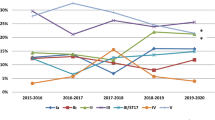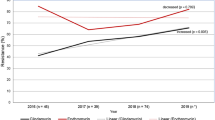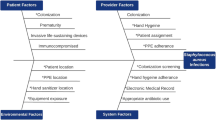Abstract
BACKGROUND AND OBJECTIVES: In 1996, the Centers for Disease Control (CDC) issued guidelines for antepartum antibiotic prophylaxis of group B streptococcal (GBS)-positive women. The objective of this study is to document results of a GBS prophylaxis policy at one nonacademically affiliated, community hospital and discern its effectiveness with regard to compliance as well as in decreasing the incidence of early onset GBS (EOGBS) disease.
METHODS: The development of a GBS-prevention policy at the Women's Hospital of Greensboro (WHG) was documented by means of interviews and examination of minutes of meetings. Effectiveness of the policy was assessed by calculating the percentage of all GBS+ or unknown mothers who received antepartum antibiotics during a 1-year period. Additionally, all newborns with any positive GBS culture during the past 13 years at WHG were identified.
RESULTS: The policy was formulated and distributed during a 6-month period by strong leadership, community “buy-in,” and an educational seminar. A preprinted physician order was written so that all GBS-positive/unknown mothers would receive antepartum antibiotics. Additionally, a clinical pathway was used to track and monitor maternal GBS status. During October 1, 1999 to September 30, 2000, 1124 (23.1%) mothers were found to be GBS positive/unknown. Of those who delivered an infant >37 weeks' gestation and who could be linked to the pharmacy database, 777 (91.1%) received antepartum antibiotics. The incidence of EOGBS disease at WHG before 1996 was 1.93±0.7/1000 births compared to 0.4±0.05/1000 after the issuance of the guidelines (p=0.002, t-test).
CONCLUSIONS: Over 90% of GBS-positive mothers were treated with antibiotics at WHG. Associated with this high adherence rate to the CDC guidelines has been a five-fold decrease in the incidence of EOGBS disease. We attribute these results to the implementation of a preprinted physician order sheet to direct intrapartum antibiotics for women with GBS positive or unknown colonization and the use of a clinical pathway to track GBS colonization status.
This is a preview of subscription content, access via your institution
Access options
Subscribe to this journal
Receive 12 print issues and online access
$259.00 per year
only $21.58 per issue
Buy this article
- Purchase on Springer Link
- Instant access to full article PDF
Prices may be subject to local taxes which are calculated during checkout

Similar content being viewed by others
References
Centers for Disease Control and Prevention. Prevention of perinatal group B streptococcal disease: a public health perspective MMWR Morb Mortal Wkly Rep May 31, 1996 45: RR-7 1–24
Schrag SJ, Zywicki S, Farley MM et al. Group B streptoccocal disease in the era of intrapartum antibiotic prophylaxis N Engl J Med 2000 342: 15–20
CDC. Adoption of perinatal group B streptococcal disease prevention recommendations by prenatal care providers — Connecticut and Minnesota, 1998 MMWR Morb Mortal Wkly Rep 2000 49: 228–32
Schuchat A . Group B streptococcal infections: from trials and tribulation to triumph and trepidation Presented at the 38th annual meeting of the Infectious Diseases Society of America, Sept 7–10, 2000, New Orleans
Jeffrey HE, Lahra MM . Eight-year outcome of Universal Screening and intrapartum antibiotics for maternal group B streptococcal carriers Pediatrics 1998 101: 1 e2
Lieu TA, Mohle-Boetani JC, Ray GT, Ackerman LM, Walton DL . Neonatal group B streptococcal infection in a managed care population. Perinatal Group B streptococcal infection study group Obstet Gynecol 1998 Jul 92: 1 21–7
Brozanski BS, Jones JG, Krohn MA, Sweet RL . Effect of a screening-based prevention policy on prevalence of early-onset group B streptococcal sepsis Obstet Gynecol 2000 Apr 95: 4 496–501
Cheon-Lee E, Amstey MS . Compliance with the centers for disease control and prevention antenatal culture protocol for preventing group B streptococcal neonatal sepsis Am J Obstet Gynecol 1998 Jul 179: 1 77–9
Stevenson KB, McMahon JW, Harris J et al. Increasing pneumococcal vaccination rates among residents of long-term-care facilities: provider-based improvement strategies implemented by peer-review organizations in four western states Infect Control Hosp Epidemiol 2000 21: 705–10
Lawson F, Baker V, McElhaney JE . Standing orders for influenza vaccination increased vaccination rates in inpatient settings compared with community rates J Gerontol A Biol Sci Med Sci 2000 55: M522–6
Yusuf HR, Mahoney FJ, Shapiro CN et al. Hospital-based evaluation of programs to prevent perinatal hepatitis B virus transmission Arch Pediatr Adolesc Med 1996 150: 593–7
Author information
Authors and Affiliations
Rights and permissions
About this article
Cite this article
Clemens, C., Gable, E. The Development of a Group B Streptococcus Prevention Policy at a Community Hospital. J Perinatol 22, 523–525 (2002). https://doi.org/10.1038/sj.jp.7210794
Published:
Issue Date:
DOI: https://doi.org/10.1038/sj.jp.7210794
This article is cited by
-
Prevention of Early-onset GBS Sepsis: Evaluation of a Changing Paradigm
Journal of Perinatology (2003)



